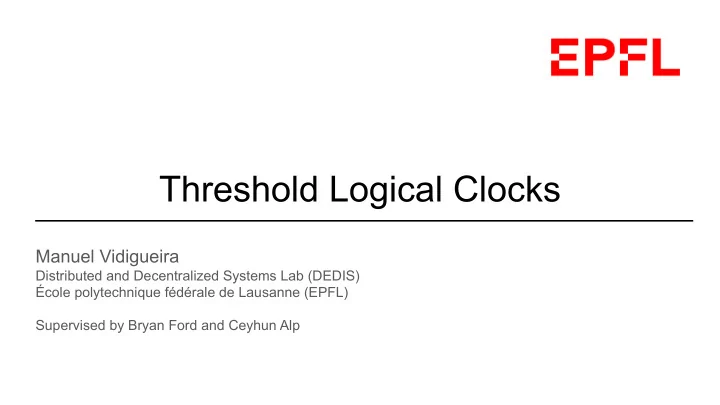

Threshold Logical Clocks Manuel Vidigueira Distributed and Decentralized Systems Lab (DEDIS) École polytechnique fédérale de Lausanne (EPFL) Supervised by Bryan Ford and Ceyhun Alp
Outline ● Motivation ● Threshold Logical Clocks (TLC) ● Experimental Results ● Using TLC ● Conclusion 2
Outline ● Motivation ● Threshold Logical Clocks (TLC) ● Experimental Results ● Using TLC ● Conclusion 3
Network models Synchronous Partially Synchronous Asynchronous - Synchronized clocks - (Mostly) Asynchronous - No assumptions - Bounded message - Eventually it behaves transmission delay like a synchronous network - Bounded processing time Easier to prove/analyse More robust 4 Can we get the best of both worlds?
Measuring time in asynchronous systems Meet tomorrow? Meet today? Yes! Meet tomorrow? Meet today? T Alice : 00:00 T Alice : 00:10 Messages are Alice ordered differently Yes! T Bob : 00:20 Meet tomorrow? Yes! Bob Meet today? Node clocks can be out of sync! 5
Logical time: vector clocks Meet tomorrow? Yes! Meet today? Meet tomorrow? Meet today? A: 1 , B: 0 A: 2, B: 0 Same order Alice (and correct) Yes! A: 1 , B: 1 Meet tomorrow? Yes! Bob Meet today? Nodes keep track of how many messages they saw from others 6
Adversarial models Crash-stop Byzantine - Nodes only fail by - Nodes can do anything crashing (behave arbitrarily) Stronger 7
Meet tomorrow? Meet today? Meet tomorrow? Meet today? Yes! A: 1, B: 0, ... A: 2, B: 0, ... Alice Messages arrive out of order Yes! A: 2 , B: 1, ... Meet tomorrow? Yes! Bob Meet today? Hey Bob... A: 2 , B: 0, ... Eve No tolerance of byzantine failures! 8
A: 3 Alice A: 3 Bob Messages lost, delayed... Everyone A: 0 else Local “time” Nodes can advance arbitrarily forward in time. No enforced group synchronization! 9
Outline ● Motivation ● Threshold Logical Clocks (TLC) ● Experimental Results ● Using TLC ● Conclusion 10
Threshold Logical Clocks Idea: ● Time is represented by a round number R ● Nodes must have received a threshold T of messages to advance to the next round and send another message. (T = 2) Alice R: 1 R: 2 R: 3 R: 0 Bob 11
TLC - Design goals Security goals 1. Fully Asynchronous 2. Byzantine Fault Tolerant No use of timeouts or Can tolerate as many byzantine synchronous assumptions. or malicious nodes as possible Performance goals 3. Liveness 4. Low latency 5. Low bandwidth usage Honest nodes must be able to Rounds should be fast and use Should scale to at least 100s of make progress (go to next round) few round trips. nodes 12
TLC Interface Every round: Round R - Provide a valid message m m S TLC - Receive a set S of valid messages (#S >= T ) A validation function f val filters bad messages 13
What we want: Round 1 Round 0 Round 2 TLC TLC TLC TLC m S m S m S Real time 14
TLC Interface Two main parameters: ● message threshold T ● acknowledgement threshold A (T,A) - TLC Certified message: ● appears in the set S of A different nodes (same round) Every set S returned by TLC: ● contains at least T different certified messages 15
Simple TLC Every round has a logical time associated to it (0, 1, 2…) Every round, each node: 1. Broadcasts its message, appending the round time 2. Broadcasts signed ACK for messages of that round 3. Waits for T messages where each has A different ACK 4. Delivers messages received and broadcast in that round 5. Increments round. 16
Communication pattern Messages for one Broadcast Acknowledgements node O(N 2 ) O(N) Simple TLC round split by trip time 17
Communication pattern Messages for all Broadcast Acknowledgements nodes O(N 2 ) O(N 3 ) ~TLC round split by trip time 18
Threshold Witnessed TLC Every round, each node: 1. Broadcasts its message, appending the round time 2. Sends signed ACK for messages of that round to their sender (T,A) - TLC 3. Waits for A Acks for its message, aggregates signatures and sends certified message (message + signature). 4. Waits for T certified messages. 5. Delivers messages received and broadcast in that round 6. Increments round. 19
Communication pattern Messages for one node Broadcast Acknowledgements Rebroadcast O(N) O(N) O(N) Threshold Witnessed TLC round split by trip time 20
Communication pattern Messages for all nodes Broadcast Acknowledgements Rebroadcast O(N 2 ) O(N 2 ) O(N 2 ) Threshold Witnessed TLC round split by trip time 21
Outline ● Motivation ● Threshold Logical Clocks (TLC) ● Experimental Results ● Using TLC ● Conclusion 22
Implementation & Experimental Setup Implementation Deterlab setup ● Go ● 10 physical machines ○ Simple: ~420 lines ○ Threshold Witnessed: ~575 lines ● Network configuration: ○ 100 Mbps bandwidth ● Libraries: ○ 200 ms round-trip latency ○ Kyber crypto library ○ 1KB payloads ○ Onet network library ● https://github.com/dedis/student_19_tlc 23
Evaluation: Bandwidth T = A = (n+1)/2 T = A = (2n+1)/3 24
Evaluation: Round Time T = A = (n+1)/2 T = A = (2n+1)/3 25
Outline ● Motivation ● Threshold Logical Clocks (TLC) ● Experimental Results ● Using TLC ● Conclusion 26
Potential Applications ● Threshold Cryptographic Signing ● Threshold Cryptographic Randomness ● Randomized Asynchronous Consensus ○ The communication logic is reduced to TLC time-steps. ○ Can be used for Byzantine consensus as well. ○ Details are currently in the works. 27
Outline ● Motivation ● Threshold Logical Clocks (TLC) ● Experimental Results ● Using TLC ● Conclusion 28
Conclusion Round X ● Threshold Logical Clocks: m S TLC ○ robust round based communication ○ group based notion of time ○ implementation with reduced bandwidth and latency ○ scales to 100s of nodes ○ many potential applications Thanks! 29
Recommend
More recommend